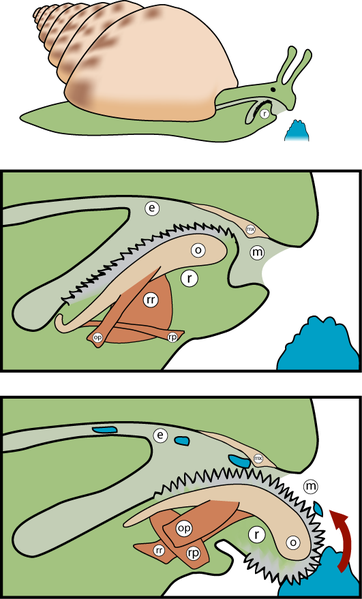
Nutrition
Most forms of land snails are strictly herbivores, but a few carnivorous forms do exist (Baker 1939, Carnegie). Although no accounts were found of the diet of Millerelix lithica, it can be assumed that they are herbivores by comparing similar species such as the Polygyra albolabris described in the Field Book of Illinois Land Snails (Baker 1939). Polygyra albolaris is a forest dwelling snail, much like Millerelix lithica, that feeds on available plant material and fungal mycelia (Baker 1939, Pilsbry 1940).
ON THE HUNT

Acquiring food is another story; land snails are not picky eaters due to limitations experienced during movement (Carnegie 2012). However, all land snails require calcium carbonate as a part of their diet (Dourson 2010). Calcium carbonate is needed to carryout a variety of functions in the body and is very important in the maintenance of the shell. (Dourson 2010). The dependence on calcium carbonate is why most land snails live in areas where limestone is abundant (Dourson 2010). Since there is ample vegetation in the Arkansas forests Millerelix lithica presides, it is a well suited habitat for this terrestrial land snail with limited range.
Picture from the Family
Polygyridae
DIGESTION

The process of digestion in M. lithica and other Pulmonates share commonalities to other high order animals. First, food is detected by chemo and tactile sensation of the two inferior tentacles (Carnegie 2012). Once food is found, gastropods as a whole use a specialized chitin containing tool located in the snail's mouth, known as the radula, to aid in digestion of food (Baker 1939, Gillis). This organ functions by grinding food particles into fine, digestible pieces very similar to mastication or chewing in humans (Baker 1939, Gillis 2012). The rest of the digestion process also resembles humans. For instance, a gastrointestinal channel exists where chemical digestion occurs by enzymes secreted by digestive and salivary glands and the food material is propagated along by peristalsis (Carnegie 2012). The anatomy of digestive system can be seen in the picture of Reproduction page.
EXCRETION
When a snail has finished acquiring the nutrients
from its meal, excretion of the undigested waste takes place.
Due to torsion of the visceral mass located in the mantle cavity of
the shell in snails, the anus releases waste contents back through the
aperture (Hickman
et al 2012).
Keep reading to understand how M. lithica reproduce!
home
|
classification |
controversy
| habitat
| adaptation
| nutrition
| reproduction
| references
|
contact
last updated November 29, 2012